Ever since there have been guns, people have wanted to be better with guns, and ever since that, people have been wanting to know how they can practice guns without all the fuss of shooting bullets at people. Chances are, that’s why you’re here, to learn about how you can use airsoft to improve your skills with real firearms! Fortunately, airsoft offers a realistic and effective way to hone some of the most vital shooting skills, with very little of the risk or cost associated with other simulation. If you go into the field of airsoft for practical training prepared and knowledgeable, you’re very likely to come out of it with experience that benefits your career, your sport or hobby, or your emergency readiness.
Related Articles:
- Interest? Airsoft Guide For Beginners [Brands, Gear, Tech, Tactics,…]
- Get Creative! Top DIY Airsoft Mods [Modifications]
- Learn Something New! Guide to Air-Smithing [It’s Easy]
- Firepower! Guide to Airsoft FPS [Test Your Limits]
- The More You Know! Airsoft History [Learn]
Common Types of Simulated Firearm Training
The idea of simulating a potentially lethal combat with a nonlethal projectile dates back to the early 20th century, somewhere around 1906 or 1907, where wax bullets were cast and fired from pistols in a simulation of a duel. Over time, the idea developed further, taking various forms such as rubber “skipping” bullets for crowd control, paintballs (which were first used for marking cattle and then for marking other humans), “simunitions” (or cartridges fired out of real (but modified) firearms that marked where they hit), and even airsoft BBs.
More recently, first responders, firearm experts, and military professionals across the globe have realized the value of simulated combat as a training tool, using all the above methods to stage various scenarios and practice firearms training without most of the hazards that accompany the use of real firearms. In particular, “force on force” training, or training that pits multiple teams against one another, has been lauded as an excellent way to prepare individuals for combat.
Reasons to Train with Airsoft
Airsoft offers a lot of capability and flexibility not necessarily available with other simulated munitions like paintball, wax bullets, or simunition, and those advantages are especially well-suited for individuals or small teams looking to improve their firearms skills.
Realism
One of the most important attributes of airsoft guns is that, externally, they’re nearly always a 1:1 copy of  a real firearm, and often approximate the weight quite closely as well. By exactly replicating the controls, trigger location, hand placement, ergonomics, and length of pull, every movement or operation performed on an airsoft replica AEG is developing muscular memory critical for a real-steel context. Also, unlike paintball guns, where the ammunition is most often poured in through a hopper, airsoft requires true-to-life magazine changes. Developing these “habits” to aid the consistency and repeatability of your actions is a crucial part of shooting for competition or self-defense.
a real firearm, and often approximate the weight quite closely as well. By exactly replicating the controls, trigger location, hand placement, ergonomics, and length of pull, every movement or operation performed on an airsoft replica AEG is developing muscular memory critical for a real-steel context. Also, unlike paintball guns, where the ammunition is most often poured in through a hopper, airsoft requires true-to-life magazine changes. Developing these “habits” to aid the consistency and repeatability of your actions is a crucial part of shooting for competition or self-defense.
Electric airsoft PTWs, or “Professional Training Weapons”, generally serve as the next level of realism for training, though at a substantially higher cost. They improve over standard, Tokyo-Marui spec AEGs by incorporating more realistic features such as last-round bolt hold open, requiring the use of the charging handle, and sometimes simulating a weak recoil (however, several new high-end products on the market, like the GBLS DAS and American Airsoft Factory rifles, are reputed to provide a much more effective recoil simulation).
Gas blowback rifles and pistols generally provide the highest level of realism, offering all the features of the above combined with a much more realistic takedown process, harder recoil, realistically-weighted magazines, and a good degree of water tolerance. Their only downsides are the cost of compressed gas and the cost of magazines.
Availability
Simunitions-style equipment is produced primarily by one supplier in the US, and only a couple distributors are licensed for each state, where airsoft is available from 30+ manufacturers, sold pretty much homogeneously throughout the United States, and most large cities have at least one dedicated airsoft store within a half-hour drive. What’s more, the large consumer base, supported by leads to a great deal of aftermarket support; this means that there are more parts available for emergency repairs and more customization options for matching your replica firearm to the real steel; in fact, my current airsoft setup is identical to my AR-15 down to the ounce!
Further, there are a large number of dedicated airsoft fields throughout the United States, offering varying terrains and scenarios. Particularly on weekdays, many of these fields offer the ability to reserve field space in a manner that’s ideal for training small to mid-sized groups of people.
Safety
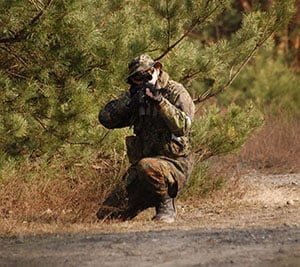 One of the important aspects of airsoft, and one of the features that makes it a feasible option for organizations with limited resources is the degree of safety provided by an airsoft-centric curriculum.
One of the important aspects of airsoft, and one of the features that makes it a feasible option for organizations with limited resources is the degree of safety provided by an airsoft-centric curriculum.
There’s relatively low muzzle energy associated with even the most powerful airsoft rifles, especially compared to simunitions or paintball. Paintballs at about 91 meters/second or 300 feet/second have an energy of 14.8 joules, where pistol-caliber simunition projectiles, at 110-150 meters/second or 360-490 feet/second exhibit roughly 5.5 joules (although their potential for injury is higher due to their relatively solid composition). Airsoft pellets (.28 grams) moving at 91 meters/second or 300 feet/second only carry about 1.17 joules.
That lower muzzle energy results in several improvements to training, chiefly by reducing the requirements for protective gear to more accurately simulate real-life combat or shooting scenarios. Both simunition and paintball are physically dangerous, and potentially capable of causing permanent harm, if you play without full face protection, hand protection to avoid broken-back fingers, and groin protection (if you’re male). In airsoft, on the other hand, low-profile goggles and a mouth guard will provide adequate protection against lasting injury under almost all circumstances. A maxim of force-on-force training is to “train as you fight”, and the minimal safety gear necessary for airsoft-based training improves field of view, reduces encumberment, and shrinks the gap between training and putting into practice.
Cost
I think I’ve saved the best for last here; airsoft is, especially compared to the competition, extremely affordable. With shrinking training budgets for many police organizations throughout the US, this affordability has become one of the most valuable characteristics of airsoft training.
The start-up cost for airsoft is certainly attractive; budget-targeted polymer bodied M4-pattern rifles are easy to find for a little over a Benjamin; add twenty dollars for full-seal, ASTM rated safety goggles, ten for a Lithium Polymer battery and another twenty for two spare magazines and you’re looking at under a couple hundred dollars a person for a simulation weapon that’s accurate out to 100 feet, features select fire capability, can take a beating, and in the event of a breakdown, has numerous community-made guides to disassembly available online and can be quickly repaired by anyone with even the slightest mechanical aptitude.
Advanced models, such as dedicated Professional Training Weapons, are available for a moderate price from manufacturers like A&K. In comparison, even the cheapest magazine-fed paintball gun comes out at a few hundred dollars, and that’s without any full-auto capability. Even that cost pales in comparison with the price of simunition, which requires both a working firearm as well as the dedicated conversion kit (price on request).
The real value of airsoft, though, is apparent after a couple years of use, and that’s in the price of ammunition. Let’s say, for the sake of argument, that your local police department wants to train its  SWAT team in clearing building and has a budget of a thousand dollars a year to pay for ammunition. Obviously, they won’t be using real ammunition, because they would prefer not to kill anyone. What system should they use for their training? If they choose to use simunition, they can afford only about 800 rounds of ammunition for their pistols; not all that much for a team of five or six people, especially if they practice frequently.
SWAT team in clearing building and has a budget of a thousand dollars a year to pay for ammunition. Obviously, they won’t be using real ammunition, because they would prefer not to kill anyone. What system should they use for their training? If they choose to use simunition, they can afford only about 800 rounds of ammunition for their pistols; not all that much for a team of five or six people, especially if they practice frequently.
If they use paintballs, even top-of-the-line ones, they’re going to be able to do a lot more training! In fact, they can afford around 25,000 paintballs, which might cover a year’s worth of intensive training. But, if they end up using high-grade, .28g airsoft ammunition…they can afford 200,000 rounds and have enough budget left over to order pizza after every session. It goes without saying that not everyone has a thousand dollar budget for training, and if you’re one of those people, the low price of BBs is likely even more attractive for you!
Reasons Not to Train With Airsoft
If airsoft was a perfect training tool, other techniques for firearms simulation wouldn’t still exist. There are certainly some circumstances where airsoft is indeed not the best tool for the job, and I’ll mention the two most frequent below:
Where Marking is Required
In many situations, established guidelines for force-on-force or other simulated firearms training require the positive identification of a hit via a visible mark. If you’ve played airsoft before, you’ve probably encountered players who were unwilling to call hits. Hopefully, individuals undergoing training would demonstrate more honesty, but it’s still entirely possible that a hit might go innocently unnoticed, undermining the realism of the training (you’d notice being hit with a real bullet). If a department, organization, or private instructor has determined the necessity for marking, airsoft is not a good choice.
(Side note: There are chalk-coated and paint-filled BBs designed to be fired out of airsoft guns. Do not use these. Both like to gum up the insides of airsoft guns in one way or another, and the paint-filled ones frequently bounce instead of bursting. Buy a paintball gun instead.)
Where Getting Hit Needs To Be Painful
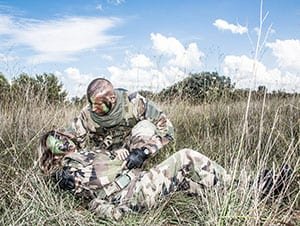 Am I implying that folks who shoot simunitions are sadists, or the targets are masochists? Absolutely not! However, there is some solid evidence that pain is an excellent instructor. Being hit with an airsoft pellet doesn’t generally pack much of a punch: it doesn’t sting much, it definitely doesn’t knock the wind out of you, it doesn’t leave an embarrassing red blotch on your gear. Both paintball and simunition do these things, and clearly define the state of having been shot as a failure, both in terms of removing you from the competition, and making you feel some pain/embarrassment as an additional negative reinforcement. When money is less important than attaining a visceral quality of training, some instructors may still choose to use paintball or simunitions.
Am I implying that folks who shoot simunitions are sadists, or the targets are masochists? Absolutely not! However, there is some solid evidence that pain is an excellent instructor. Being hit with an airsoft pellet doesn’t generally pack much of a punch: it doesn’t sting much, it definitely doesn’t knock the wind out of you, it doesn’t leave an embarrassing red blotch on your gear. Both paintball and simunition do these things, and clearly define the state of having been shot as a failure, both in terms of removing you from the competition, and making you feel some pain/embarrassment as an additional negative reinforcement. When money is less important than attaining a visceral quality of training, some instructors may still choose to use paintball or simunitions.
More Related Articles:
- What’s Different? Types of Airsoft Magazines [Choices!]
- Charge it Up! Guide to Airsoft Lipo Batteries [Information]
- Common Guidelines! Airsoft Safety [Equipment Suggestions]
- Boom! How do Airsoft Grenades Work? [How to Use Them]
- This or That? Airsoft vs. BBSs [Know the Difference]
How Can You Use an Airsoft Gun for Training?
Up to this point, I’ve focused heavily on the role of airsoft in force-on-force trainings/combat simulation, but airsoft equipment can fulfill a number of training roles in place of more expensive alternatives; about the only thing it can’t be used for is precision marksmanship! For each role, I’ll also make some recommendations about the ideal type of airsoft gun to fit it.
Familiarization
Do you know someone who’s never handled a gun before? The sort of person who doesn’t know which end goes bang, and would almost certainly sweep everyone on the firing line if handed a pistol? Well, believe it or not, that was me twelve years ago. After realizing I knew nothing about guns, I taught myself some firearm safety and basic shooting technique with a $10 UHC-brand spring pistol and a pair of safety glasses. If I can do it, then, believe me, anyone can, and that’s why I’m suggesting that every firearm novice should be introduced to airsoft first, preferably through a spring-powered pistol or rifle. Others might recommend something such as an inert training firearm for teaching familiarization, but spring-powered airsoft guns offer prices three to five times lower and give novices the chance to get some rudimentary time on the trigger by firing low-powered airsoft projectiles.
Beyond teaching newbies which end the bullet comes out of, a cheap spring-powered gun can also assist in familiarizing them with some of the core rules of firearms, such as Colonel Jeff Cooper’s Four Rules of Safe Gun Handling:
- All guns are always loaded
- Never let the muzzle cover anything you are not willing to destroy
 Keep fingers off the trigger until ready to shoot
Keep fingers off the trigger until ready to shoot- Be sure of your target and what’s beyond it
If you personally aren’t familiar with the Four Rules, read up on them here. Airsoft provides a safe, stress-free context for gradually introducing these vital rules to a novice without the immediacy or perceived danger of handling a loaded, potentially lethal firearm.
Lastly, even cheap plastic airsoft guns are usually 1:1 scale to the real firearm, and that makes them invaluable tools for teaching stance and posture. With a rifle, work to emphasize keeping the feet spread apart for stability, adjusting the stock (if possible) to a comfortable length, pulling the stock tight into the shoulder pocket, and leaning into the rifle to minimize the recoil that would result from a real rifle. With a pistol, the most important fundamental is keeping full control over the direction of the muzzle at all times; the bore axis is often extremely short which makes it easy to accidentally sweep the muzzle across another person. Also important: encouraging the use of both hands to maintain grip and teaching how to avoid inadvertently engaging the magazine release.
Manipulation and Handling
Beyond just learning the basics of how to keep a hold on a firearm and maintain the proper stance, there is an enormous number of precise muscular movements and shooting techniques to keep track of, whether they be for pistol, rifle, or shotgun. In nations where actual firearms are difficult to obtain, airsoft guns are often used as approximates, something that can be seen in the organization of AIPSC competitions throughout Europe and Asia.
Here’s a short list of drills to run through to practice manipulation of controls, magazines, and other equipment.
Basic
Mag Change:
The goal of this drill is to familiarize your body with the act of removing from and inserting magazines into your gun.
With your primary hand holding the gun by the grip, remove your secondary hand and eject the 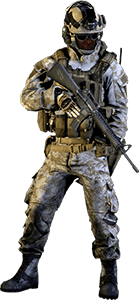 magazine using the most convenient finger (on either hand), catching it and returning it to a pouch or dump pouch. Then withdraw the second magazine from your belt or pouch and insert it, racking the bolt/slide or releasing the bolt release/slide stop as necessary to chamber the first round. Try to get the whole process under five seconds!
magazine using the most convenient finger (on either hand), catching it and returning it to a pouch or dump pouch. Then withdraw the second magazine from your belt or pouch and insert it, racking the bolt/slide or releasing the bolt release/slide stop as necessary to chamber the first round. Try to get the whole process under five seconds!
Safe/Semi/Auto (For Select Fire Guns Only):
The goal of this drill is to prepare you to make quick-fire mode changes to adapt to fast-changing situations. Prepare three targets about 25 feet away
Start with the rifle set on semi-automatic. Insert one magazine, and fire one round at each of the targets. Switch to automatic, fire one five-round burst (exactly) at each of the targets, switch to safe and remove the magazine. Try to get to the point where the fire mode selection takes a negligible amount of the total time! This is particularly hard for AKs with their right-side selector.
Intermediate
Breakdown Shakedown (For Gas Blowback Guns Only):
The goal of this drill is to prepare you for a field-expedient repair by reducing the time it takes for you to get your rifle or pistol taken down into its main components (At the minimum, for rifle: bolt, upper, and lower, for pistol: slide, barrel, and frame.)
Start by firing a string of fifteen rounds semi-auto, then remove the magazine, release the hammer, and strip the weapon down on the nearest clean or flat surface. Reassemble, reinsert the magazine, cock, and fire.
Mag Change, Round Two:
The goal of this drill is to develop the ability to perform a tactical mag change. Prepare a soft surface, such as carpet or grass, to avoid damaging dropped magazines.
With your primary hand holding the gun by the grip, remove your secondary hand and withdraw the second magazine from your belt or pouch, then use the most convenient finger (right index on an AR, 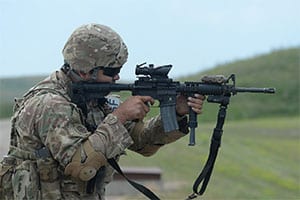 left thumb for an AK, etc.) to eject the spent magazine, then insert the full one and give it a smack to ensure it’s seated. Return the spent magazine to its pouch, a dump pouch, or, to save time, let it fall onto a soft surface. Try to get the time down to three seconds if dropping or using a dump pouch. Some professionals can do it in slightly over one.
left thumb for an AK, etc.) to eject the spent magazine, then insert the full one and give it a smack to ensure it’s seated. Return the spent magazine to its pouch, a dump pouch, or, to save time, let it fall onto a soft surface. Try to get the time down to three seconds if dropping or using a dump pouch. Some professionals can do it in slightly over one.
Biathalon:
The goal of this drill is to develop the ability to combine precision snap-shooting with periods of strenuous activity, approximating a rush to cover or fast advance/flanking maneuver. Prepare by positioning yourself a distance from cover with a series of small pie-tin size targets set up at least 50ft from the cover.
Begin with the rifle at low ready and sprint your selected distance to your targeted cover, taking care to avoid pulling muscles and maintain healthy breathing. Take a position behind cover and fire three aimed shots at each target, then jog back to the starting position. If you can’t make space for longer runs, try using wind sprints (“suicides”) instead to ramp up breathing, exertion, and heartbeat.
Advanced
Change is Good (Rifle Only):
The goal of this drill is to prepare you to adopt multiple shooting stances to adapt to a changing tactical environment. Prepare three targets about twenty-five feet away and set up some form of cover large enough to crouch behind. Ideally, have a friend randomize the placement of the targets while you’re behind cover.
From behind cover, shoulder the rifle to your right shoulder and lean out, being careful to minimize your visible profile. Fire four to five semiautomatic shots that connect with the target, then duck back into cover. Lean left, shouldering the rifle to the left shoulder this time, and let loose a short burst at a second target. Pop up and engage each target over the top of the obstacle, then duck in, run five feet to your right, and go prone, again engaging each target. Try to ensure every shot is a hit and continue to reduce your time for the exercise.
 Transition to Sling (Rifle and Pistol Only):
Transition to Sling (Rifle and Pistol Only):
The goal of this drill is to prepare you to quickly free your hands of your rifle in order to accomplish other manual tasks, such as climbing a ladder or drawing a sidearm. Use a two or three-point sling setup.
This drill is pretty much what it says on the tin: the transition from rifle to pistol as quickly as possible by letting the rifle fall against its sling, brushing it out of the way, and then drawing and firing a magazine of ammunition from a pistol.
Gear/kit Setup
In my opinion, using airsoft to test various setups of one’s issued or personally purchased equipment is one of the places where it truly shines, and also where it gets very little credit. Especially with modular gear such as PALS/MOLLE equipment, there are an enormous number of different ways that a given number of pouches, straps, and buckles can be configured, and practicing with and making user-expedient modifications to gear can shave seconds off reload times, reduce the chances of getting tangled in your fasteners, and reduce the amount of unsecured weight swinging around on a vest.
In general, my recommendation is, if you’re going to use a specific type of chest rig, plate carrier, or load-bearing equipment for real-world applications, to play several airsoft games in it while having it set up the same way it would be in the real world. This gives you time to make fit adjustments, relocate awkward pouch positions, and potentially add small modifications such as reinforced stitching or additional velcro space so that when you really need your equipment to be the best it can be, it’s already been tested in simulated combat.
Force-on-Force
Force-on-force is the most visible sort of training conducted with simulated munitions, and it can take many forms: one-on-one training preparing individuals for handling a threat to their life, hostage scenarios for SWAT teams and special forces, or training on responding to an active shooter threat in an institutional environment. There are three steps to creating an effective force-on-force training event, the scenario, the setup, and the execution.
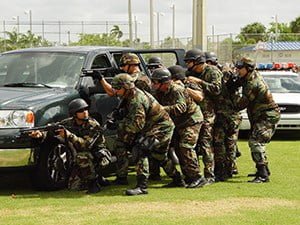 The scenario is, to borrow a phrase from literary analysis, the “inciting incident” that the instructor is preparing trainees to respond to. It could be a hostage-taker entering a local cafe, it could be a mugger approaching the trainee in a dark alley, it could be a crazed-seeming man clutching a rifle in the middle of a street (perhaps to give the trainees experience with rules of engagement). The important thing is to choose a scenario that fits the challenges the trainees expect to face and to create a realistic environment, and oftentimes, it’s easy to do both of these things by basing the scenario on historical events, such as high-profile crimes or terrorist attacks.
The scenario is, to borrow a phrase from literary analysis, the “inciting incident” that the instructor is preparing trainees to respond to. It could be a hostage-taker entering a local cafe, it could be a mugger approaching the trainee in a dark alley, it could be a crazed-seeming man clutching a rifle in the middle of a street (perhaps to give the trainees experience with rules of engagement). The important thing is to choose a scenario that fits the challenges the trainees expect to face and to create a realistic environment, and oftentimes, it’s easy to do both of these things by basing the scenario on historical events, such as high-profile crimes or terrorist attacks.
The setup is twofold; it encompasses the creation of the environment based on the realities of the scenario, including things like the number of enemies, accurate light levels, obstacles, cover, and concealment, and it governs the entrance points and potential tactics offered to the trainees
The execution encompasses the information, equipment, and preparation that’s given to the “good guys” and the “bad guy(s)”. In general, the “good guys”, or trainees, should have much less information on the situation than their opposing force, forcing them to rely on basic skills and competencies to successfully complete the scenario. In some cases, imperfect information may be provided, such as under- or over-reporting the number of known enemies.
Airsoft For Firearms Training Final Thoughts
Airsoft is not a perfect training tool. But, it offers enormous capability, sometimes even surpassing much more expensive tools like simunitions, at a fifth or tenth of the cost. If you as an individual want to train yourself on firearms basics without any of the potential for injury associated, you want to introduce a novice to firearms, or you want to train with a group on basic tactics, airsoft is an excellent tool for those purposes and more! Thank you for visiting iamairsoft.com! For great products and more information about the game, check out our Airsoft Buyers Guides and Airsoft U!
Even More Related Articles:
- It’s All Important! Airsoft BB Weight [Everything BBs]
- Enhance Your Experience! CO2 vs Green Gas [Get blowback…]
- Question: Does Airsoft Hurt? Airsoft vs Paintball Pain [Ouch!]
- Did That Bush Move? BDU vs. ACU [The Differences Explained]
- Airsoft Laws: Are Airsoft Guns Legal in Your State?
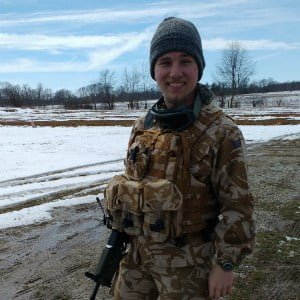
Noah Mains is a writer, an airsofter, and most importantly, he’s stuck in the 80s. From Colt SMGs to David Bowie to brick phones, he has an acute appreciation for the greatest decade, and is more than happy to share his enthusiasm for the ALICE gear system (the superior loadout, of course) with anyone who’ll listen.

